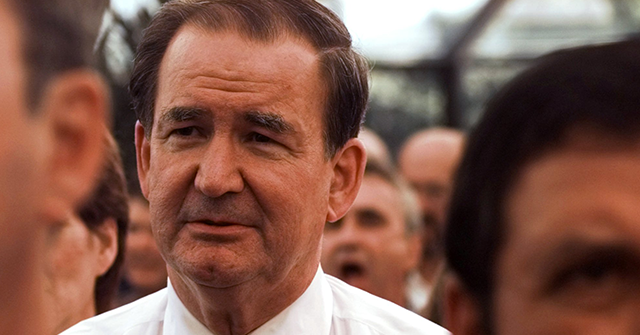Patrick J. Buchanan: The Prophet of American Trade Policy
When Pat Buchanan campaigned for the Republican presidential nomination in the 1990s, he made tariffs a central pillar of his platform. He warned that unchecked globalization would hollow out American industry, erode the middle class, and leave the nation vulnerable to economic dependence. His message resonated—he won the New Hampshire primary in 1996 and reshaped the conversation within the GOP.
A new working paper released this month asks what would have happened if the country had adopted Buchanan’s ideas sooner.
The answer: the United States would likely be richer, and more industrially balanced, today.
Photo from the 1996 campaign of Republican presidential hopeful Pat Buchanan speaking in front of a building for lease with the sign “GONE TO MEXICO” for a business that outsourced jobs due to U.S. trade policies. (Steve Liss/Getty Images)
In “Trade Policy and Structural Change,” economists Hayato Kato, Kensuke Suzuki, and Motoaki Takahashi simulate the effects of a major policy shift—what if the U.S. had raised tariffs on imported manufactured goods by 20 percentage points starting in 2001? Their model finds that such a policy would have boosted national welfare by 0.36 percent and raised the manufacturing share of the economy by about one percentage point.
What does a 0.36 percent welfare gain mean in real terms? It’s equivalent to a permanent increase in real consumption—enough that, over a lifetime, the average American household would have enjoyed the purchasing power of an extra $7,200. By contrast, economists’ estimates of the gains from the now-defunct Trans-Pacific Partnership (TPP) ranged from just 0.1 to 0.12 percent of GDP—making the modeled benefit from Buchanan-style tariffs roughly three times larger.
That counterfactual tracks remarkably closely with what Buchanan advocated: a return to national industry, bolstered by protective tariffs, to restore economic sovereignty.
Tariffs, Income, and the Shape of the Economy
The paper does more than revisit a political argument. It challenges how economists have modeled trade and growth for decades.
Unlike standard trade models, which assume consumers always spend in fixed proportions regardless of income, the authors use a more realistic assumption known as nonhomothetic preferences. That means as people get richer, they shift their spending toward services and away from goods. The model also includes sectoral complementarity—the idea that manufacturing and services aren’t easy substitutes, but interlinked in production and consumption.
These dynamics help explain structural change, the long-term transition in advanced economies from goods production to service provision. By raising the relative price of imported goods, tariffs partially slow this drift and redirect spending—and capital—back into domestic industry. That shift, in turn, raises income. The two effects pull in different directions: higher prices favor manufacturing, but higher incomes pull spending toward services. In the model, the price effect wins, leading to more manufacturing and a lasting improvement in real income.
The Retaliation Question
The authors also model what happens if other countries respond with identical tariffs of their own. In that scenario, U.S. welfare falls by 0.12 percent—a modest loss that wipes out the gain from unilateral action.
But theory doesn’t always match practice.
When President Trump imposed broad tariffs during his first term, many U.S. trading partners responded not with retaliation but with negotiation. Canada and Mexico agreed to rewrite NAFTA. Japan and South Korea entered new trade talks. China signed the Phase One agreement. More recently, as the Trump administration has introduced a new round of tariffs on computer chips, cars, and green tech, foreign governments have mostly refrained from counter-tariffs.
Instead of matching duties, many countries have sought exemptions, adjusted their export strategies, or reduced their own barriers. As the authors acknowledge, the real-world response to U.S. tariffs has looked far more like strategic accommodation than tit-for-tat escalation.
A Modest Gain, But a Real One
No one argues that a 0.36 percent welfare gain is transformational. But in economic policy, it’s not trivial. It’s larger than the projected gains from nearly every modern trade agreement, and—importantly—it is permanent. The authors’ result implies a permanently higher level of real consumption, one that grows in value over time.
And the shift in sectoral composition is notable: a one-percentage-point increase in the manufacturing share of GDP is significant in the context of an economy that saw that share fall from 16 percent in 1999 to just under 11 percent today.
The authors are careful not to oversell their result. Their model assumes efficient recycling of tariff revenues, frictionless capital markets, and gradual adjustment. But they also show that older models—those assuming fixed preferences and easy substitution between sectors—tend to overstate the costs of protection and understate its structural impact.
A Different Starting Point
The economic debate over tariffs is no longer binary. Policymakers no longer start from the assumption that any deviation from free trade must be distortionary. Instead, the new question is what trade policy is for—what national goals it serves, and what tools are available to shape long-run economic structure.
This paper offers one answer. A well-designed tariff policy—targeted, sustained, and matched with domestic investment—can raise real income and preserve industrial capacity. It won’t reverse globalization, but it can tilt the playing field back toward American producers.
It also affirms something Buchanan understood early: free trade is not neutral, and neither is its retreat. The shape of an economy is a policy choice.
Had the country made a different choice in 2001, the model suggests, Americans might be $7,200 richer today—with more factories still running.
Read the full article here
